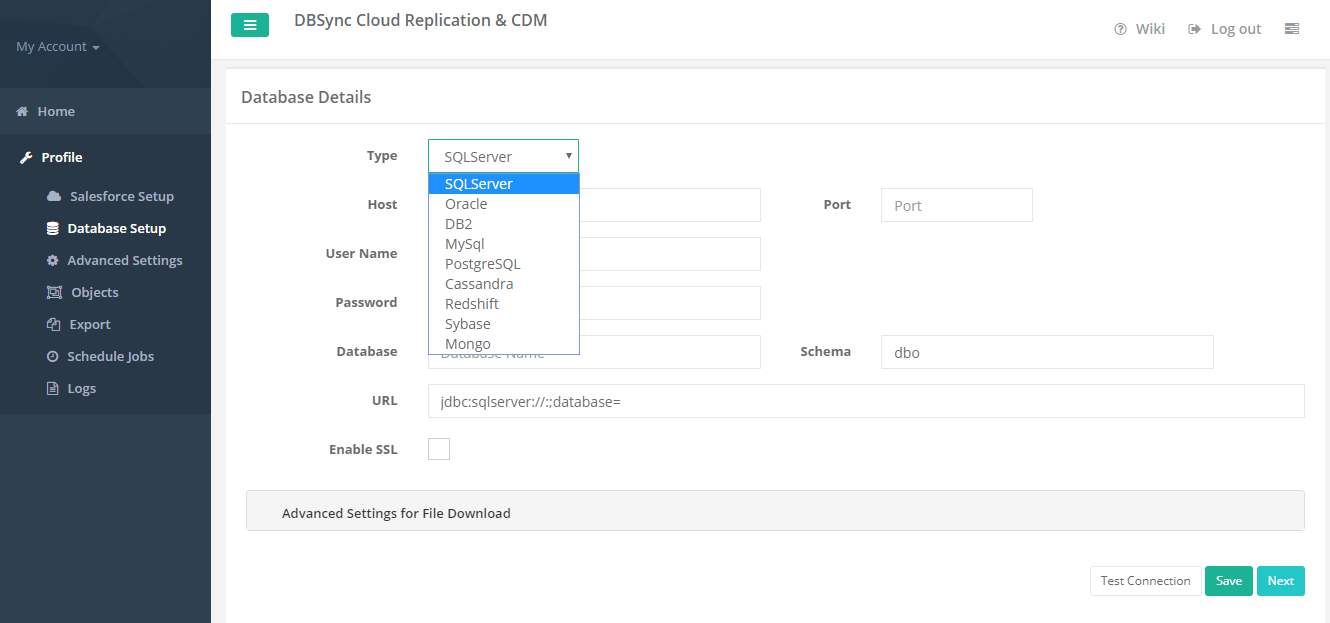2022
Page History
...
- Click to "Database" Setup tab on the left hand corner in the Profiles section of DBSync Replication Portal.
- Select, the required "Type name" from the drop down menu options like "MySql, SQL Server, Oracle, DB2, PostgreSQL, Cassandra, Redshift, Sybase and Mongo" under the "Database Setup" section.
Note: The database URL can also be entered manually if you know your database Connection string. - To start with Database credentials user has to entered all the configuration details like Host, Port, Username, Password, Database Name and Schema.
- Once, all the details enter by the user then URL details will get autofilled. (Note: The database URL can also be entered manually if you know your database Connection string.)
- Click on Test Connection button to validate your Source Application login details.
- Click on Save button to save your Source Apps login details.
- Once completed, click on Next button to proceed to Advanced Settings tab to write the email Id to get the Notifications.
...
- Click to "Advanced" Settings tab on the left hand corner in the Profiles section of DBSync Replication Portal.
- Mark the checkbox to "Enable Database logging" to create auto created table in the database.
- Next, Mark the checkbox of "Email only on Error" to get an email message when error will occur.
- Enter an email for "Email Recipient" to get the notification when any run command is executed.
- Click on Save button to save your Advanced settings details.
- Once the process is completed then click on Save & Next buttons to proceed further.
Source Application Objects tab
Start with Source Application Objects tab, to get synced all the objects when user will get connected to different source applications like Salesforce/Microsoft CRM.
Follow these steps to synced all objects for source application like Salesforce and Microsoft CRM.
- Click to "Objects" tab on the left hand corner in the Profiles section of DBSync Replication Portal.
- Once, user has connected to source applications like Salesforce and Microsoft CRM then objects will get synced and it will show on the Objects tab.
- Select any Source Apps objects you want to sync into Database from the left Objects section as shown below.
- Select the object fields you want to sync into Database from the "Available Fields" section and use "Exclude Fields" section to filter out fields you don't want to sync into Database.
- Once completed, click on the "Run button" to Run the configuration for the Source Apps object.
- Run menu to select the required commands like Update Database Schema, Source Apps to Database (Clean Copy), Source Apps to Database (Incremental) to execute.
Below section explains the steps involved
...
- in Source Apps to Database Replication.
Run Process | Actions Performed |
Update Database Schema | Creates Source Apps schema into Database for the selected Source Apps objects. |
Source Apps to Database (Clean Copy) | Inserts a clean copy of selected Source Apps object records into respective Database Tables & Columns. |
Source Apps to Database (Incremental) | Performs an incremental syncfrom Source Apps to Database based on the changes / edits made in Source. |
DBSync Replication tool must be installed in your system. Step by step procedure for installation is shown in the topicInstallation.
...
Note: The database URL can also be entered manually if you know your database Connection string.
While replicating with Cassandra, please refer the following wiki link for specific details on Replication with Cassandra.
http://help.mydbsync.com/docs/display/CloudReplication/3+-+Big+Data+Support
...
In Source Apps Sync Details section, you can select the Source Apps objects you want to sync into Database from the left Objects section as shown below.
Select a Source Apps Object from Objects section, select the object fields you want to sync into Database from the Available Fields section and use Exclude Fields section to filter out fields you don't want to sync into Database. Once completed, click on the Run button to Run the configuration for the Source Apps object.
You can also useFilter Criteriafor adding filters to specific fields using basic SOQL operators. Once completed, click on the Run Command button to run any command. Once, you have clicked then it will redirect to you on the Log Screen Tab to see the status of command is completed or not.
Once command is executed then you will get the email in your mailbox as per the details submitted by you in Advanced Settings tab for Notifications.
At this point your Replication profile is ready to sync your Source Apps and Database applications as per configurations. Initiate the sync using the Run menu to select the required process to execute.
You can also schedule the sync using theScheduler Tab.Select the required Process from theCommand Drop-down and configure the frequency of the sync by selecting a desired duration from theRepeat drop-down. The below screenshot illustrates configuring scheduler functionality.
Once you have selected all the options then go to the Starts On option and select the Date, Month and Year from the Drop-down menu.
Once the process is completed then click onSave&Nextbuttons to proceed further.
Once, you have saved all the details in the Scheduler Jobs tab then it will automatically create a task in the task section with all the details including Task Name, Action, Command and Start Date and Time.
...


